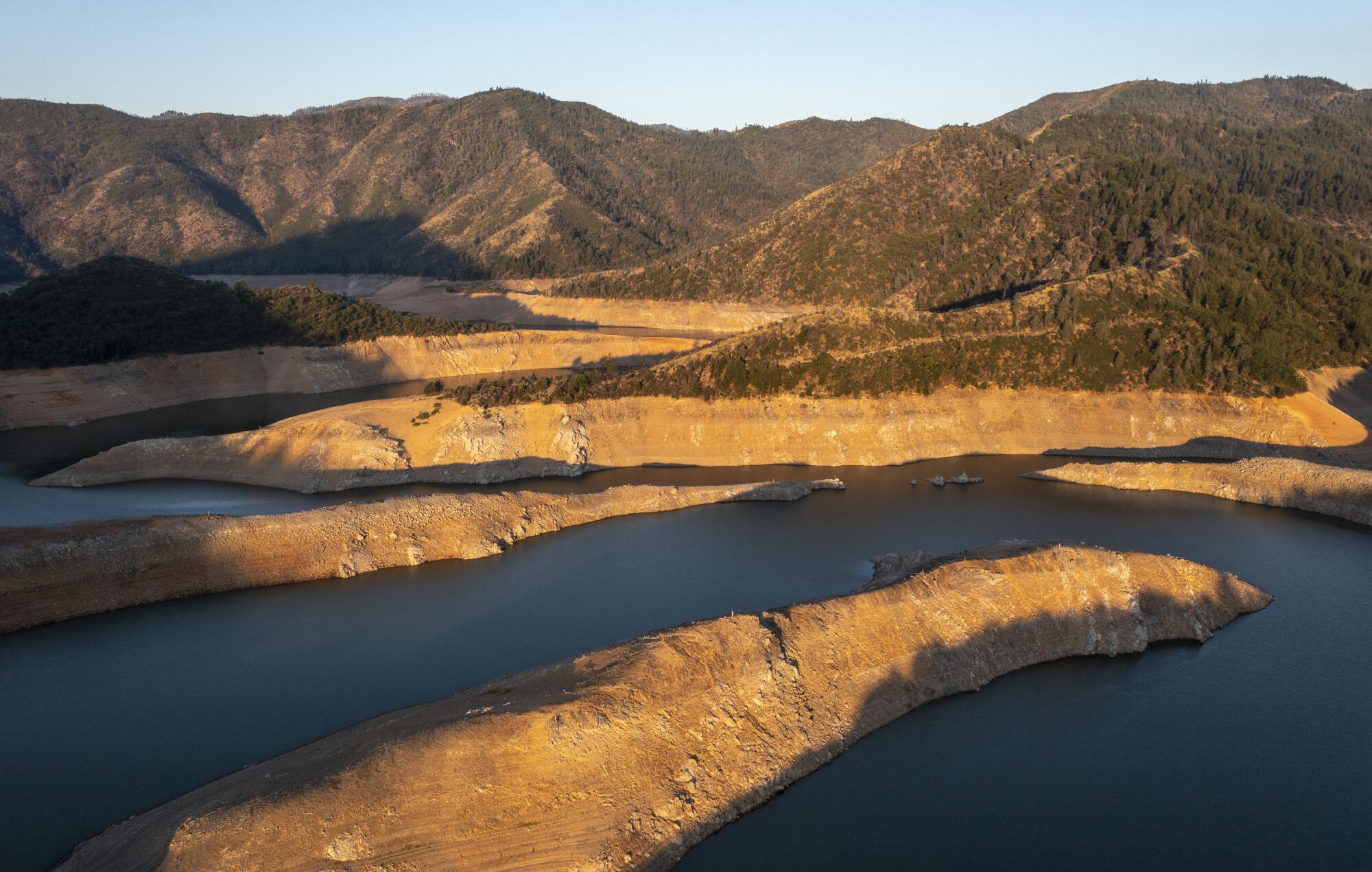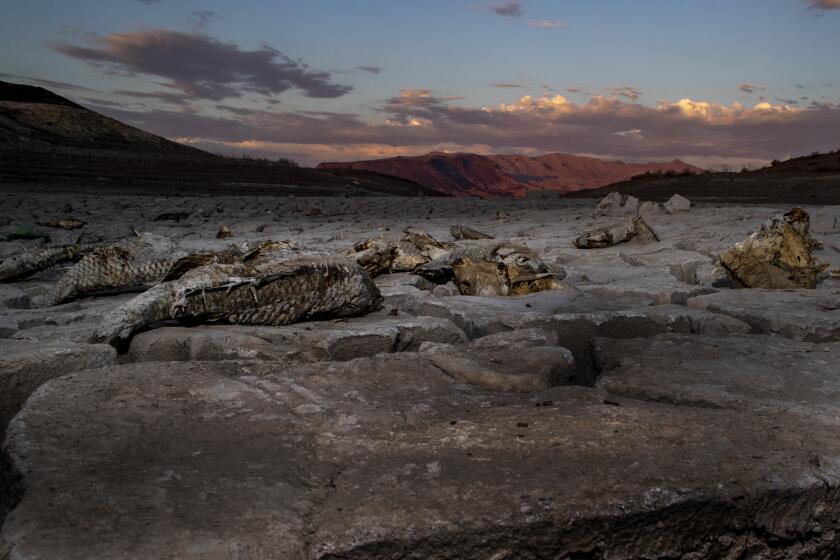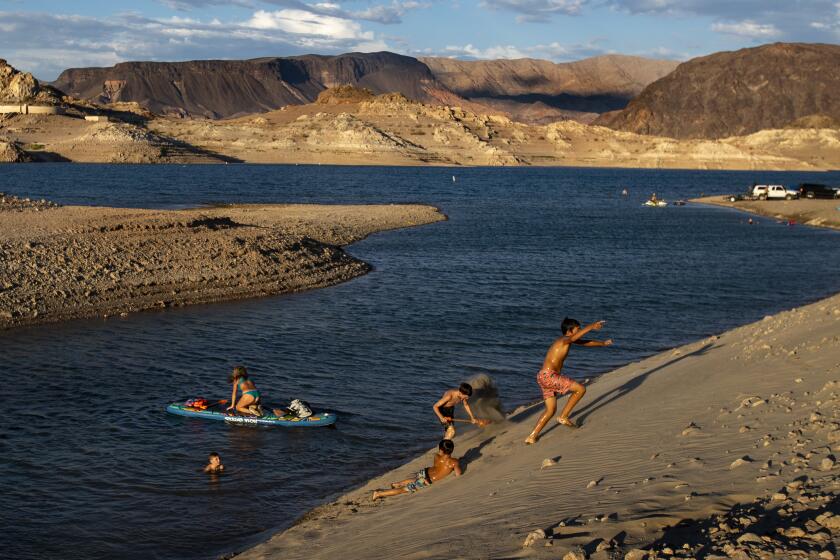
- Share via
- New research shows global warming has become the dominant driver of worsening droughts in the Western U.S.
- Scientists say the severity of future droughts will be determined largely by how much more planet-heating gases humans release into the atmosphere.
Humanity’s heating of the planet, driven by the burning of fossil fuels and unchecked emissions of greenhouse gases, has become the main driver of worsening droughts in California and the American West, according to new research.
A team of UCLA and NOAA scientists found that while droughts in the last century were caused mainly by decreases in precipitation through natural cycles, an entirely different pattern has taken hold as a result of the rising temperatures this century.
The researchers determined that since 2000, human-caused warming has become the dominant force leading to more drought severity in the Western United States. In the case of the intense Western drought from 2020 to 2022, the scientists attributed 61% of its severity to high temperatures, and only 31% to reduced precipitation.
“For the same precipitation deficit, drought now is much stronger than it used to be in the 20th century, and drought also lasts longer,” said Rong Fu, a UCLA climate researcher and study coauthor. “That makes drought more severe and more extensive.”
Even after a year and a half of wet weather, research shows the American West has experienced the driest 25-year period in 1,200 years. When might the megadrought end?
She and her colleagues analyzed data from 1948 to the present in 11 Western states from California to Colorado. They found that since 2000, human-caused warming has not only become the dominant factor in the severity of drought, but also in expanding areas affected by drought conditions.
Examining potential future scenarios, the researchers said climate models indicate that an extreme drought like the one from 2020 to 2022 — an event that without warming would likely occur once in more than a thousand years — could become a 1-in-60-year event by the middle of this century, and potentially a 1-in-six-year event by the end of the century.
The researchers, including scientists at NOAA’s National Integrated Drought Information System in Boulder, Colo., wrote that human-caused warming has “ushered in an era of temperature-dominated droughts.”

“The degree of aridification and intensification of droughts in the region depends on the extent of anthropogenic warming,” the researchers wrote in the study, which was published Wednesday in the journal Science Advances.
The scientists said their findings, which add to a growing body of research documenting climate change’s role in worsening droughts, underscore an urgent need to reduce planet-warming emissions while also changing water management and drought strategies to adapt to the new reality of heat-driven dry spells.
They said the results indicate the West will become drier as climate change continues to push global temperatures higher.
“How dry, how severe, depends on our actions. Basically, we have control on what droughts look like in the future. That hasn’t happened in human history,” Fu said. “Future drought is mainly determined by how warm it gets, and how much CO2 we emit. So first and foremost is to control the CO2 emissions.”
New research examines how much global warming has sapped the Colorado River since 2000. It shows the region has lost more water than Lake Mead can hold.
The outlook for reducing U.S. carbon dioxide emissions has dimmed, however, with Donald Trump’s victory in the presidential election. Trump has pledged to scrap the Biden administration’s climate initiatives and efforts to curb emissions, and has vowed to facilitate more oil and gas drilling.
Trump’s victory might mean closing a window of opportunity to avoid dangerous climate impacts “if we do not fight back and double down our effort to curb CO2 emissions,” Fu said.
“I am very concerned for the future of the Western U.S., the U.S. as a whole and the world, especially because we are at such a critical moment for limiting catastrophic impacts from climate change,” Fu said. “However, history also shows that our action matters. We should not let Trump’s administration decide our future and the future of our children and grandchildren.”
The effects of increasing CO2 concentrations in the atmosphere have become increasingly apparent over the last decade.
Last year was by far the warmest year on record globally. According to NOAA, Earth’s average temperature was more than 2.4 degrees warmer than the average in pre-industrial times. The U.N. warned in a recent report that without greater action to stop emissions, the world could see as much as 5.6 degrees of warming by 2100, bringing “debilitating impacts to people, planet and economies.”
Along with extreme heat, people in the Western United States have experienced some of the driest conditions recorded. California was ravaged by the state’s driest three years on record from 2020-22.
The Newsom administration is projecting that California’s State Water Project could lose up to 23% of its water delivering capacity within 20 years.
Other scientists have similarly found that global warming is having a major effect in worsening drought conditions.
Researchers using tree-ring records determined in a 2022 study that Western North America was experiencing its driest 22-year period in 1,200 years. They found that this megadrought wouldn’t be nearly as severe without global warming, estimating that 42% of its severity was attributable to higher temperatures.
Benjamin Cook, a climate scientist at NASA’s Goddard Institute for Space Studies who co-authored the megadrought research, said the methods in the latest study are sound and the findings are similar, though he also said there is considerable uncertainty in the future projections the scientists used.
“The impacts on drought scale with warming,” Cook said. “So the more warming that happens, the more drying we expect in this region. And that means more severe, more extensive and more frequent drought events.”

Warming contributes to drier conditions by increasing what scientists call evaporative demand. Higher temperatures enhance the atmosphere’s capacity to hold water vapor, increasing the quantities of moisture evaporating off the landscape. This leaves the land drier and contributes to reductions in stream flows.
Experts say more intense droughts supercharged by climate change will require significant shifts in agricultural water use because farms consume most of the water that is diverted and pumped in the West — roughly 70% to 80% depending on the region. Along the drought-stricken Colorado River, the federal government has recently been funding programs that pay farmers to temporarily reduce water use in exchange for payments.
The average flow of the Colorado River, a major water source for seven states and northern Mexico, has shrunk about 20% since 2000, and scientists have estimated that roughly half that decline in flow has been caused by the higher temperatures. Those declines are projected to continue to worsen as temperatures climb.
Imperial Valley farmers left fields dry temporarily to help ease the Colorado River’s shortage. The program has led to concerns about the shrinking Salton Sea.
The latest study is thorough and adds to previous research documenting how human-caused warming is driving what scientists describe as hot drought and aridification in the West, said Brad Udall, a climate scientist at Colorado State University.
“They found, just like all these other studies, that higher temperatures have been, and are going to be, a cause of more severe droughts as it warms in the 21st century,” Udall said. “That means that we need to plan for a hotter and drier future.”
Udall said Trump’s win will likely mean rolling back the Biden administration’s historic climate initiatives and imposing a four-year hiatus on U.S. efforts to reduce greenhouse gas emissions domestically and abroad.
“Unfortunately, the impacts are likely to last much longer than just four years,” Udall said. “All of this means that the worst outcomes envisioned by this study will be more likely. And, of course, all the other climate change problems, like more and bigger floods, monster hurricanes, and deadly heat waves, will get worse in lockstep.”
Udall said he finds it especially sad that Trump plans to freeze efforts to address climate change at a time when the country has the necessary science, technologies, policy tools and people who are working on solutions.
“We know how to solve this problem,” Udall said. “Much of this will now be sidelined to pursue an anti-science agenda that will further enrich the gigantic companies that created this problem in the first place.”
Toward a more sustainable California
Get Boiling Point, our newsletter exploring climate change, energy and the environment, and become part of the conversation — and the solution.
You may occasionally receive promotional content from the Los Angeles Times.











